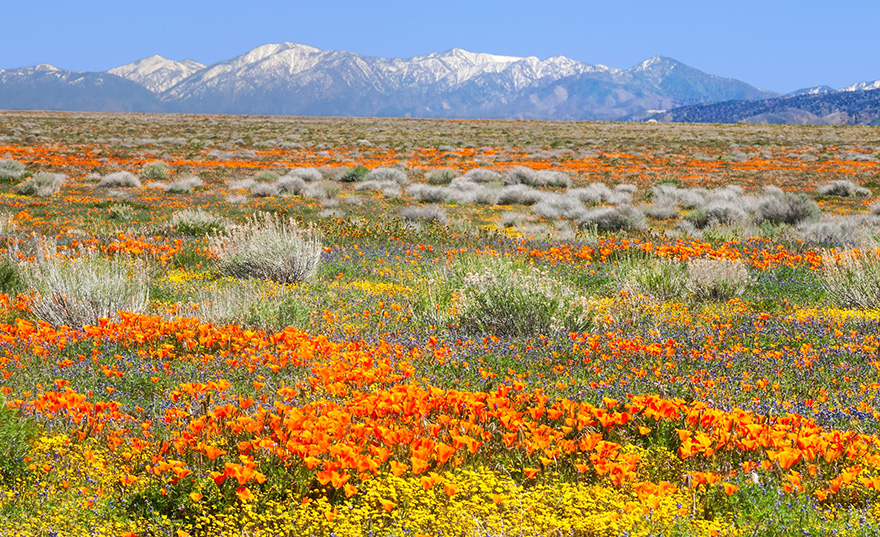A lifelong interest in the environment and photography did more than launch one married couple’s relationship. It gave Rob Badger, 73, and Nita Winter, 66, the means to find and inspire environmental collaborators and inspiring them through their awe-inspiring images of nature in the American West – a 30 year labor of love.
A meeting…
They met in a San Francisco photo lab in 1986. “I was waiting for my prints, and my prince showed up,” Winter jokes. Back then, she was a photographer of people. Badger had just quit his job, deciding to be a photographer full-time. A native of rural Massachusetts, Badger was studying aerospace engineering in Los Angeles when his interest in the natural world…blossomed.
“I spent time photographing the diverse and dramatic beauty of my new state, especially California’s different desert ecosystems, containing landscapes and plants completely new and exciting to me,” Badger says. He dropped out, took classes in the natural sciences and later became a photographer for the Audubon Society, Nature Conservancy and Trust for Public Land by approaching them – and being approached as his specialty grew.
“Learning nature photography changed my life completely”’
“Learning nature photography changed my life completely,’” says Badger. The more he learned how human activities like mining, logging and wastefulness threatened such beautiful places, the more he resolved to use his talents to protect them.
…and a revelation
In 1992, Badger was so moved by the sheer majesty of a superbloom – extraordinary flower blooms in deserts caused by sudden rain – he was photographing in the Antelope Valley in southern California’s Mojave Desert, he called Winter at their Bay Area home to join him. Blown away by the waves of orange poppies and purple flowers, she decided to team up with him, later forsaking her people photography career entirely. But sights like “Monet’s Carpet,” their nickname for a beautiful lavender and yellow landscape an hour north of Los Angeles, were worth it.
Spreading the word
The duo’s outreach efforts to find collaborators and supporters for the environment through their gorgeous images of nature in the West started in earnest – and by accident. While volunteering, the duo met the San Francisco public library programs director who suggested their work become a travelling exhibit. Their exhibit, with educational text on native plants and climate change to accompany their photos, debuted at the library in 2016.
“Rob and I decided to become voices for wildflowers, combining visual and literary storytelling with our love of nature”
The couple then turned it into a book of 190 photographs and 18 essays on nature conservation from a roster of scientists and activists., Beauty and the Beast: California’s Wildflowers and Climate Change, after networking with fellow members at Bay Area Independent Publishers. The pair approached non-profits, and attended a conference about global environmental and social problems, called Bioneers, to round up the essays.
Rob Badger, 73, and Nita Winter, 66, won the Sierra Club’s 2020 Ansel Adams Conservation Photography award for photographing wildflowers for almost 30 years. Their gorgeous images of nature in the West became a traveling exhibit after they met the San Francisco public library programs director, who suggested it.
“Rob and I decided to become voices for wildflowers, combining visual and literary storytelling with our love of nature”
“Rob and I decided to become voices for wildflowers, combining visual and literary storytelling with our love of nature,” says Winter. “Our goal is to help people fall in love with wildflowers and inspire action to save them.” Videos of their Zoom talks are here.
The environment is so important because “We are all interconnected, and human activity that changes the climate is the greatest threat to the natural world,” she explains. “We must take action to reverse these threats.” Their weapon: Photography. Nowadays, it’s easy to learn, thanks to great smartphone cameras, and how-tos on Google and YouTube. To mark Earth Day – and beyond – they recommend:
- Joining online groups focused on nature, conservation etc. on Meetup or Facebook, or garden or nature photography clubs, to share ideas and photos.
- National, state and local parks and native plant society chapters organize efforts to plant native species to restore biodiversity and remove invasive species.
- Buy less, re-use more. Re-use paper printed on just one side, consolidate errands to save gas, limit use of plastics, packaging and food waste and flush the toilet with dishwater.
- Become a citizen scientist. Help scientists on research projects by collecting data on plants and animals through websites like Nature’s Notebook and iNaturalist.
- Combine a skill you have to help the environment, from fundraising to community outreach.

Authors of “Beauty and Beast: California’s Wildflowers and Climate Change” coffee table book. Part of Rob Badger and Nita Winter’s fine art documentary photography project “Beauty and Beast: Wildflowers and Climate Change” a sponsored project of Blue Earth Alliance.
Peter Raven, Jose Gonzalez, Wendy Tokuda, Kenna Kuhn, Kitty Connolly, Erin Schrode, Dr. Margaret Leinen, Will Rogers, Gordon Leppig, Susan Tweit, Mary Ellen Hannibal, Genevieve Arnold, Ryan Burnett, Doug Tallamy, Ileene Andersen, Robin Wall Kimmerer, Amber Pairis,
OLD TEXT BELOW
A lifelong interest in the environment and photography not only cemented one married couple’s relationship, but helped them connect with, and inspire, others through their awe-inspiring images of nature in the American West.
Nature photographers Nita Winter, 66, and Rob Badger, 73, won the Sierra Club’s 2020 Ansel Adams Conservation Photography award for photographing wildflowers on U.S. public lands for almost 30 years, especially superblooms, spectacular flower displays in the Southern California desert after rainstorms. A traveling photo exhibit they created became a coffee-table book with 190 photos of wildflowers, plus 16 essays about nature conservation they collected from scientists and regular citizens, Beauty and the Beast: California’s Wildflowers and Climate Change.
Wildlife and nature
“Rob and I decided to become voices for wildflowers, combining visual and literary storytelling with our love of nature,” says Nita. “Our goal is to help people fall in love with wildflowers and inspire action to save them.” Just one favorite, a gorgeous lavender and yellow landscape they dubbed “Monet’s Carpet,” is about one hour north of Los Angeles in Gorman.
Why is the environment so important? “We are all interconnected, and human activity that changes the climate is the greatest threat to the natural world,” she adds. “Also, the natural balance of life is being destroyed, and species are becoming extinct, due to ever-expanding land development and resource extraction. We must take action to reverse these threats.”
“Learning nature photography changed my life completely, and led to my being ‘more ecological,’” he says. The more he learned how human activities like mining, logging and wastefulness threatened such beautiful places, the more he resolved to use his talents to protect them.
Another life-changing event occurred in 1992. Rob was so taken by the majesty of a superbloom he was shooting in the Mojave Desert’s Antelope Valley California Poppy Reserve – waves of glowing oranges and purples – he called Nita to join him. Between gigs as a documentary photographer at the time, she was so blown away by the sheer beauty, she later switched to nature photography to work with Rob.
Photography is easy to learn nowadays, thanks to great cameras on smartphones, they explain. How-tos on smartphones and photography are easy to find on Google or YouTube.
Tips on saving the environment include:
- Join online groups focused on nature, native plants, conservation etc. on Meetup or Facebook, or garden or nature photography clubs. Share ideas and photos online or in real-life meetings.
- Plant native species to restore biodiversity and animals’ natural habitat, and remove invasive species, through efforts organized by national, state and local parks and native plant society chapters.
- Buy less, re-use more. Nita and Rob re-use paper printed on just one side, consolidate errands to save on gas, limit use of plastics and packaging and flush the toilet with dishwater.
- Become a citizen scientist. Help scientists on research projects by collecting data on plants and animals, through websites like Nature’s Notebook and iNaturalist.
- Combine your interest in nature with a skill you have. Whether it’s fundraising or community outreach, use your talents.
Photos by Nita Winter and Rob Badger.





